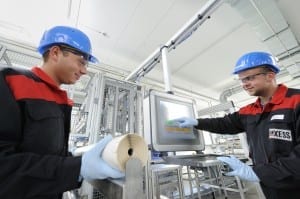
Virtual engineering allowed research and development to proceed simultaneously.
Together with the specialty chemicals company LANXESS, Fraunhofer researchers have engineered and built a system in record time, which produces reverse osmosis membrane elements for water treatment. Virtual engineering allowed research and development to proceed simultaneously.
Only around 0.3 percent of the world’s water supply can be used directly as drinking water. At the same time, the world population is growing steadily, thus increasing the need for clean water constantly. Water treatment technologies such as reverse osmosis will be instrumental in ensuring that we have enough to drink in the future: A membrane filtration system removes substances such as salts, pesticides, viruses and bacteria from water. In early 2010, the specialty chemicals company LANXESS decided to enter a new field of business, water treatment. It planned to have a high-tech production facility built by the fall of 2011in Bitterfeld, the location of IAB Ionenaustauscher GmbH, a LANXESS subsidiary. This ambitious plan meant that both the product and the manufacturing technology had to be designed and ready for manufacturing in very short time. LANXESS intended to bring outside expertise on-board to engineer the automation and hit upon the Fraunhofer Institute for Factory Operation and Automation IFF right in the area.
The researchers had little time for preparation. “Research and development had to proceed in parallel, which is why we relied on virtual engineering from the outset,” says Prof. Ulrich Schmucker, Manager of the Virtual Engineering Business Unit at the Fraunhofer IFF. “It enabled us to start on work very early, which would not get done in a conventional approach until the final stage of development.”
Simulating filter elements on the computer
Since the membrane filter elements, which were to be manufactured at the production facility, did not exist yet, a team of experts der IAB GmbH and the Fraunhofer IFF first analyzed the product features on the computer with the aid of various simulations. This was necessary in order to determine important manufacturing parameters, such as speed, which also played a role later when the system was designed. Researchers subsequently used the virtual models of the semi-automatic system to run through and optimize the individual steps of the process. They were also able to estimate the manpower it would require.
Thus, the design engineers already had very clear specifications for the ensuing CAD. That was not all, though. The researchers from Magdeburg have developed a special method that makes it possible to start programming a control system already based on the relatively rough CAD model. Programming is usually not done until the end when the equipment has been built and hooked up. However, it is virtually impossible to modify the equipment any longer at that time. “We, on the other hand, connect the real control system to the virtual model. Then, we watch the movements of all of the parts relative to one another on the monitor. This enables the programmer to check the correctness of sequences, eliminate errors and exceptions or even perform collision analyses,” explains Prof. Schmucker. When necessary, the design engineer makes changes before the equipment has even been built.
Not least, consulting with a client becomes significantly easier. “Ideas about a user interface’s appearance often tend to be very abstract at the beginning,” explains Prof. Schmucker. “When the client has a clear mental picture, however, it is much easier to plan and identify the required control elements expediently.” The decision to enter a new realm of development with VR models proved its worth for LANXESS, too. Jean-Marc Vesselle, Head of the Ion Exchange Resins Business Unit, is convinced that, “virtual engineering is certainly going to take on greater importance for us in the future.”
via Fraunhofer
The Latest Streaming News: Virtual engineering updated minute-by-minute
Bookmark this page and come back often
Latest NEWS
Latest VIDEO








